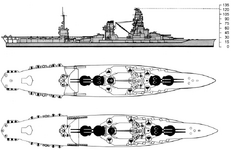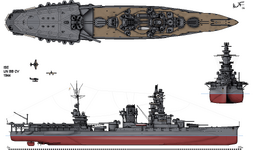AA armaments in Oct 1944. So very little difference between I & H and Zuikaku, the largest carrier in Ozawa's force in Oct 1944.I'm trying to communicate that the hybrids survived because they had a lot of AA. IIRC, Shokaku and Zuikaku (purpose built carriers) did have a lot of AA like you predicted. Yet their AA wasn't able to drive off dive bombers targeting Zuikaku. As impractical as hybrids design was, credit where credit is due. Somehow Ise and Hyuga's ineffective guns did drive off a f-ton of aerial bombs and torpedoes. Doesn't that count for something? It's frankly weird that no one is willing to recognize this.
By the way, random info here: there's a source on Japanese Wikipedia which claims both hybrids used radar guidance for ship targeting. But I don't have any sources as to its FCS. My guess is it used manual targeting against aircraft.
Ise & Hyuga
The 14in guns were equipped with a limited number of sanshiki-dan / sankaidan incendiary shrapnel rounds, some of which were fired when the attackers were still at long range.
16x5in AA (8x2)
104 x25mm (31x3, 11x1)
6x28 barrelled unguided rocket launchers firing incendiary shrapnel shells.
Zuikaku
16x5in AA (8x2)
96x25mm (21x3, 33x1)
6x28 barrelled unguided rocket launchers firing incendiary shrapnel shells.
As for the 25mm this is from the Navweaps site:-
"The Japanese considered the 25 mm gun to be an excellent weapon, but it did not compare well to either the Bofors 40 mm or to the Oerlikon 20 mm weapons used by the Allies.
The magazines for the Type 96 held only 15 rounds, so frequent stoppages for change outs were required. By 1945, these weapons fired projectiles too light and too short ranged to effectively engage the heavier and faster US aircraft then in service."
For the TF38 aircrews in Oct 1944, the carriers were the primary target against which the bulk of their effort was directed initially. Chitose was left sinking after strike 1 and Zuiho & Zuikaku badly damaged. Strike 2 left the Chiyoda crippled and ablaze, while Zuikaku and Zuiho managed to drive off many of the aircraft from this strike attacking them. Strike 3 saw Zuikaku finally succumb to 6 torpedo hits and Zuiho to torpedo & bomb hits. It is only in the late afternoon that Ise came under a heavy attack in strike 4 with many near misses being made. For there to be "near misses" the USN aircraft must have been pressing home their attacks, not being put off by the weight of fire coming from the Ise.. The heavy AA fire from I & H, when they were in close proximity to the carriers during at least part of the day failed to save any of them. So for all the weight of AA armament, very little "driving off" was done by any IJN ship and certainly not by Ise & Hyuga.
I & H seem to have led a charmed life that day and the next. Both aircraft (late in the day) and submarine torpedos aimed at them missed altogether, while most of the bombs aimed at them also missed, albeit some close enough to cause some relatively minor damage.
By 1944 large Japanese warships were equipped with
Type 21 - an air search set
Type 13 - air search set. HYuga picked up the first USN strike on this set at 105 miles.
Type 22 - surface search set. It could generally not be used for fire control as its range error was too great.
Neither did the IJN use its radars for fighter control. But having the radars at least gives the gunners warning of an impending attack and the direction from which it is coming which is always useful.
Edit. Ozawa sending I & H ahead of the carriers on the night of 24/25 Oct was simply another part of the deception to draw TF38 north away from guarding Leyte Gulf. Their plan was to draw out the US fast battleships into a night action, which usually favoured the Japanese. However I & H accompanied by 4 destroyers were spotted by a radar equipped Hellcats on search missions around 0200-0230 some 80 miles north of TF38, with the rest of Ozawa's force 40 miles north of that. By 0700 on 25th the entire IJN force was back together never having engaged the US surface action TF34 assembled to engage it.
Admiral Lee was ordered to form his battle line (TF34) drawn from ships of TF 38 and sail about 10 miles ahead of the carriers That comprised the 16in battleships Iowa, New Jersey, Massachusetts, South Dakota, Washington & Alabama, 2 CA, 3 CL and 14 destroyers. More than enough to overpower the IJN "Vanguard Force" had they encountered each other.
Last edited:


